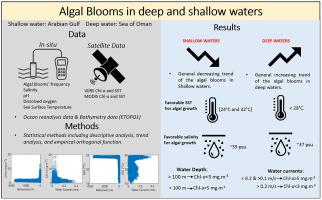Ocean & Coastal Management ( IF 4.6 ) Pub Date : 2021-08-16 , DOI: 10.1016/j.ocecoaman.2021.105840 Maryam R. Al-Shehhi 1 , David Nelson 2 , Rashed Farzanah 3 , Rashid Alshihi 4 , Kourosh Salehi-Ashtiani 2

|
The outbreaks of algal blooms occur in both shallow and deep-water bodies with varied frequencies in different seasons. To investigate the occurrences of algal blooms in these two different water bodies, we consider the Arabian Gulf (shallow) and the Sea of Oman (deep) as examples for this study. In this work, we have used a recent unique and comprehensive in-situ dataset of the frequent algal blooms collected over the last decade in the Arabian Gulf and Oman Sea. This data includes algal blooms' frequencies as well as seawater properties including sea surface temperature (SST), Dissolved Oxygen (DO), salinity and pH. In addition, we have used satellite SST and chlorophyll-a (Chl-a) data, ocean reanalysis data of water currents and bathymetry data. These data have been analyzed through statistical methods including descriptive analysis, trend analysis, and empirical orthogonal function. The results obtained demonstrate a general decreasing trend of the algal bloom events from 2010 to 2018 in the shallow waters while in the deep waters the trend is increasing. We reveal a clear seasonality with the highest frequency and Chl-a concentration of algal blooms during winter and spring. The frequent occurrences of algal blooms during winter is due to favorable SST between 24 °C and 32 °C in shallow waters and up to 28 °C in deep waters. Although salinity differs in the shallow waters (~39 psμ) and deep waters (~37), but algal blooms are found to be tolerant to these different salinity ranges as well as at pH of 8 in both regions. Chl-a commonly exceeds 10 mg m−3 in the shallow waters (<100 m) and at water currents between 0.1 and 0.2 m/s. And it is less than 10 mg m−3 in deeper waters (>100 m) and at water currents exceeding 0.2 m/s. Even at optimum levels of SST and water depth algal blooms cannot occur if there is insufficient supply of nutrients.
中文翻译:

表征浅水道和深水道中的藻华
藻华爆发发生在浅水体和深水体,不同季节发生频率不同。为了调查这两个不同水体中藻华的发生,我们将阿拉伯湾(浅水)和阿曼海(深水)作为本研究的示例。在这项工作中,我们使用了最近十年间在阿拉伯湾和阿曼海收集的频繁藻华的最新独特而全面的原位数据集。这些数据包括藻华的频率以及海水特性,包括海面温度 (SST)、溶解氧 (DO)、盐度和 pH 值。此外,我们还利用卫星SST和受叶绿素一(Chl-一) 数据、水流的海洋再分析数据和测深数据。这些数据已经通过统计方法进行了分析,包括描述性分析、趋势分析和经验正交函数。所得结果表明,2010-2018年浅海藻华事件总体呈减少趋势,而深海藻华事件呈增加趋势。我们揭示了频率最高的明显季节性和 Chl- a冬季和春季的藻华集中。冬季频繁发生藻华是由于浅水区 24 °C 至 32 °C 之间的有利 SST 和深水区高达 28 °C 的有利海温。尽管浅水 (~39 psμ) 和深水 (~37) 的盐度不同,但发现藻华能够耐受这些不同的盐度范围以及两个地区的 pH 值为 8。在浅水区 (<100 m) 和 0.1 至 0.2 m/s 的水流中,Chl- a通常超过 10 mg m -3。在更深的水域(>100 m)和超过 0.2 m/s 的水流中,它小于 10 mg m -3。如果养分供应不足,即使在 SST 和水深的最佳水平下,也不会发生藻华。


























 京公网安备 11010802027423号
京公网安备 11010802027423号